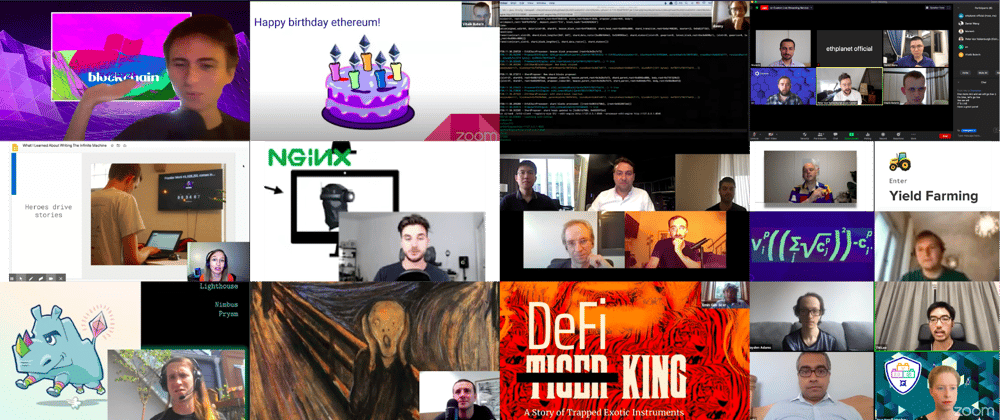From eth2 updates to thought-provoking discussions to key insights by the leaders and builders
EDCON 2020 took place virtually for the first time last week. It was a packed three days of development updates, announcements, insights, and demos. More than 2,000 Ethereumers and blockchain enthusiasts attended EDCON online and we pride ourselves on bringing together leaders and builders from around the Ethereum world who are shaping the way we live, work, and innovate.
All the keynotes and panels can be replayed on LinkTime and ETHPlanet YouTube channel.
Vitalik Buterin: From ETH1 to ETH2, Opportunities and Challenges
“Yay, 5 candles for 5 years,” Ethereum founder Vitalik wished Ethereum blockchain Happy Birthday at the beginning of his keynote. Then he gave us a general overview of Ethereum 2.0, from the goal to the history, from proof-of-stake philosophy to the eth2 Medalla testnet to the long-term roadmap. “To reduce risks, eth2 deployment process is split into phases,” said Vitalik. Testing is one of the “remaining challenges” — “Testing is hard and we know that from the experience we had in eth1.” As for the “unknowns”, he said, “I am confident that proof-of-stake is going to be better, but at the same time, we have to admit that proof-of-stake and sharding these two both contain these unknown unknowns.”
Ethereum 2.0: The Journey, the Excitement, the Gas Price, the Staking, and the Testnet
Eth2 is one of those topics that gets people curious and excited at the same time. Whether you’re new to eth2, or you’re just getting started and setting up and running a validator on the Prysm testnet, the Day 1 of EDCON packed out everything you need to know about eth2.
Danny Ryan, the core researcher at Ethereum Foundation, talked about the state of the eth1 and eth2 merger. “One really exciting part of this is what we’ve been building eth2 over the past two years is it’s essentially a piece of software that is a highly sophisticated consensus mechanism — it can handle hundreds of thousands of validators and it can handle dozens of shards,” Danny said. “So in the phase 1.5 version of the software, these two pieces of software (eth1 and eth2) live and work together.” “Eth1 is like the user layer and eth2 is the system layer,” Danny further explained. In the end, he showed us a demo of eth mainnet running on eth2’s beacon chain.
Another core researcher Hsiao-Wei Wang gave us an introduction about eth2 phase 1. Hsiao-Wei said they’re planning to introduce an EIP-1559 style approach for the fee market to adjust the gas price. She also talked about crosslinking, custody games, shard networking, the challenges, and more.
Afri Schoedon, the blockchain operations at Byzantine Fault joined us and talked about the final road to Ethereum 2.0 and gave us a little bit of background about how seven client teams gathered together last September and decided to make clients “talk” and work on single-client and multi-client testnets. Afri thinks the final milestones will be around October and November this year, “if everything works out.”
The eth2 Medalla testnet went live right before the EDCON 2020. We had Terence Tsao from Prysmatic Labs shared with us the 8 lessons that he and his team have learned from building the Onyx testnet, including accounts UX improvements, initial syncing improvements, and more. And as you probably already know that in the past weekend, a bug almost crashed the network and Terence’s team released an update to fix the bug within a short period of time.
Gas prices surged to an all-time high last week, so there’s no better time to take a deep look into the gas price and explore the possible solution. Tomasz Kajetan Stańczak, the founder of Nethermind, shared his new improvement proposal — EIP-1559 for the Ethereum gas price. “The most important thing for me is that the basefee will be observable on-chain, so something that you really don’t have access to at the moment from the perspective of the virtual machine will be available for the smart contracts… so the gas price that can no longer be manipulated by the miners,” Tomasz said. “We should see less volatility of gas price much and more predictability.”
Rolling up on Layer 2
Karl Floersch, CTO of Ethereum Optimism, opened his talk very positively by saying “Today we’re gonna talk about a lot of optimistic stuff.” “The current latency is 15 seconds in the best case and that is too high, we want it to be 5 seconds… and we need to increase the throughput.” He talked about how we can use Optimistic Rollup and the OVM (Optimistic VM) to safely increase Ethereum throughput and L2 scalability. Then he shared how to reduce time to transaction confirmation with transaction sequencers and use MEVA (miner extractable value auction) to redirect miner fees to support the network.
The co-founder of Fuel Labs John Adler shared his thoughts on scaling Ethereum with Optimistic Rollups, too. “Number of consensus nodes has nothing to do with throughput. Because consensus is not the bottleneck,” said John. “Decentralization is measured by the cost to run a full node, it is not the number of the full nodes or the number of nodes in general and this is a social contract.” The design paradigm of Rollup is you do execution off-chain and you only use Ethereum for data availability. With Rollups, “the consensus nodes (miners) and so on and also non-consensus nodes (users) only need to make data available and order it and they don’t have to execute the transactions” — that’s why can Rollups scale. And John did a comparison for Optimistic Rollup and zkRollup and told us what’re the unique benefits of Optimistic Rollup.
“Scalability = Increasing throughput without increasing node load,” said Alex Gluchowski, the CEO of Matter Labs, the team behind the zkSnyc.
Alex compared the multiple scaling solutions and also did a side-by-side comparison for zkRollup and Optimistic Rollup. Then Alex gave us an update on zkSnyc — the zkRollup protocol implementation, and their Reddit scaling challenge submission with a demo showcase of how zkSnyc works in the end.
Cross-Chain Composability and a Multichain World
“Regardless of whatever vision you subscribe to for the future of this space, whether that’s eth2 with a bunch of different shards or layer 1 or layer 2 with a bunch of different layer 2 options, we’re going to end up in a multi-chain world,” said Arjun Bhuptani, the co-founder of Connext. The current experience completely takes away the interoperability and composability, so we need 3 things: Users can transfer funds across chains, users can call contracts on other chains, and contracts can call contracts on other chains. That’s why Arjun and the team are building Connext — “a point-to-point network that allows you to make unbreakable commitments off-chain”. They also built a simple swap UI Spacefold so you can instantly transfer assets across different L2s and it looks pretty cool.
DeFi: The Current State of the DeFi and the Path to Mass Adoption
Stani Kulechov, the founder and CEO of Aave (Aavesome) kicked off Day 0, the first day of EDCON. “Aave started in January, we basically started from ‘zero’ and as same for Compound and Maker. And today in terms of the size, it has grown a lot. This is good in a sense of adoption,” Stani said. “DeFi is risky business… and smart contract audits do not guarantee safety.” That’s why Aave has been building Aave protocol with incentive design to empower and improve safety. “There is a lot of things happening now in the liquidity and the mining space and you should not compromise your security on that (reward programs that you’re participating), you should think twice and think about what are the risks involved and how the risks handled, and this is really important.”
“Our goal in DeFi is not to create a system that is just generating risk, I think the goal is to basically create a system that interoperable anyone can deploy things and new products, but at the same time, the risk is mitigated that everyone can participate into the protocols,” said Stani.
Avalanche co-founder, Emin Gün Sirer told us a “story” of trapped exotic instruments on blockchain — DeFi King, and of course, the computer science professor at Cornell had to dress up as Joe Exotic for a little while. He told us that the current state of the DeFi has two problems, one is “the infrastructure is abysmal” and the other one is “it is inward-facing”. He started exploring the solutions to enhance the performance and scalability by showing us three case studies: DEX, prediction markets, and corporate debt.
In his summary, “DeFi can fix this, but only if its infrastructure problems are fixed…the performance problem, the scale problem, and the difference between these two and I alluded to some of the control problems that DeFi faces today,” said Emin. “We believe that a chain design for low latency, high throughput, and control over the network will open up the stage for fast competitive, externally-facing DeFi instruments.”
Jordan Lyall, the DeFi product lead at ConsenSys, shared about his work on DeFi Score, a community-driven effort to bring transparency and accountability to DeFi. Jordan also gave us some great advice on how to approach risk as a DeFi user: You need to realize that security is on a sliding scale, don’t expect someone else to educate you and do your own research, and when it doubt sit it out. And how to approach risk as a DeFi developer? Jordan suggested that you can create a culture of vigilance, focus on the user, and build in safety by default.
Compound founder Robert Leshner, Synthetix founder Kain Warwick, Curve founder Michael Egorov, and fintech strategist Hao Wei had a panel discussion about how to take DeFi mainstream. The moderator, Dragonfly Capital founding partner Alexander Pack asked tons of great questions during the one-hour-long panel and one of them was “one single thing could move DeFi forward the most if happen today?” Robert and Hao said it’s “time”, and Michael and Kain’s agreed on “scalability”.
“Heroes drive stories.” — Camila Russo, Founder of The Defiant
That’s it from this year’s EDCON and THANK YOU everyone for tuning in. We really hope to see each of you at EDCON 2021 and we can’t wait to hear more stories from you!
--
Read more here







Latest comments (0)